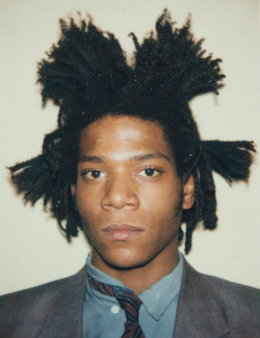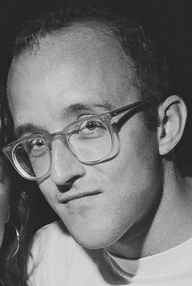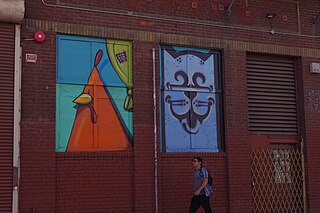
Graffiti is writing or drawings made on a wall or other surface, usually without permission and within public view. Graffiti ranges from simple written "monikers" to elaborate wall paintings, and has existed since ancient times, with examples dating back to ancient Egypt, ancient Greece, and the Roman Empire.

Jean-Michel Basquiat was an American artist who rose to success during the 1980s as part of the Neo-expressionism movement.

Keith Allen Haring was an American artist whose pop art emerged from the New York City graffiti subculture of the 1980s. His animated imagery has "become a widely recognized visual language". Much of his work includes sexual allusions that turned into social activism by using the images to advocate for safe sex and AIDS awareness. In addition to solo gallery exhibitions, he participated in renowned national and international group shows such as documenta in Kassel, the Whitney Biennial in New York, the São Paulo Biennial, and the Venice Biennale. The Whitney Museum held a retrospective of his art in 1997.

Michael Christopher Tracy, known as Tracy 168, was an American graffiti artist. He pioneered the art form known as wildstyle. Tracy 168 came to be known as one of the most influential graffiti and street artists of all time, as variations of wildstyle writing spread around the world. He is acknowledged to have been a seminal figure in the development of street art. Books about 1970s graffiti feature his car-long paintings with their characteristic kinetic script embellished with flames, arrows as well as cartoon characters and the "Tracy face," a grinning shaggy-haired visage in wrap-around shades.
Michael Jerome Stewart was an African-American man who received recognition after his death following an arrest by New York City Transit Police for writing graffiti in soft-tip marker or using an aerosol can on a New York City Subway wall at the First Avenue station. His treatment while in police custody and the ensuing trials of the arresting officers sparked debate concerning police brutality and the responsibilities of arresting officials in handling suspects. This was a widely publicized episode in New York City's history of police brutality cases.

Donald Joseph White, "DONDI" was an American graffiti artist.

SJK 171, a.k.a.Steve the Greek is a New York City graffiti artist who was active during the late 1960s and 1970s. A native of Washington Heights, he was a founding member of United Graffiti Artists, one of the first professional graffiti collectives.
SAMO is a graffiti tag originally used on the streets of New York City from 1978 to 1980. The tag, written with a copyright symbol as "SAMO©", and pronounced Same-Oh, is primarily associated with the artist Jean-Michel Basquiat, but was originally developed as a collaboration between Basquiat and Al Diaz.
Clayton Patterson is a Canadian-born artist, photographer, videographer and folk historian. Since moving to New York City in 1979, his work has focused almost exclusively on documenting the art, life and times of the Lower East Side in Manhattan.

Cristian Gheorghiu is a Romanian born street artist/graffiti artist and under the name of Smear in the 2000s. He's been referred to as "a subculture sensation" and his work has appeared in contemporary art galleries, and a solo museum exhibit in 2009. He was also a defendant in a civil lawsuit filed by the L.A. City attorney's office, a lawsuit which largely because of its First Amendment implications has garnered the attention of international media, including the Huffington Post, L.A. Weekly, the Los Angeles Times, and the Associated Press.
Michael Anthony Pegues is an African American visual artist living in New York City.
Kunle Martins is an American artist. He was born in 1980 in New York, where he currently lives and works. In 1997, Martins founded IRAK, a graffiti crew that included Dash Snow, Dan Colen and Ryan McGinley among others.

The Death of MichaelStewart, known as Defacement, is a painting created by American artist Jean-Michel Basquiat in 1983. The artwork is Basquiat's response to anti-Black racism and police brutality. It memorializes the death of Michael Stewart at the hands of New York City Transit Police for allegedly writing graffiti in the subway. No graffiti was found, according to Stewart's girlfriend at the time of his death.
The Fun Gallery was an art gallery founded by Patti Astor and Bill Stelling in 1981. The Fun Gallery had a cultural impact until it closed in 1985. As the first art gallery in Manhattan's East Village, it exposed New York to the talents of street art by showcasing graffiti artists like Fab 5 Freddy, Futura 2000, Lee Quiñones, Zephyr, Dondi, Lady Pink, and ERO. Contemporary artists Kenny Scharf, Jean-Michel Basquiat, and Keith Haring also had solo exhibitions at the Fun Gallery.

A Pile of Crowns for Jean-Michel Basquiat is a 1988 painting created by American artist Keith Haring. The artwork was made to memorialize his friend, artist Jean-Michel Basquiat. It depicts a towering pile of Basquiat's trademark crowns.

Rick Ordonez, also known as Atlas and known colloquially as the "kitty cat tagger," is an American graphic designer and graffiti artist from Alhambra, California.

Andy Mouse is a series of silkscreen prints created by American artist Keith Haring in 1986. The character Andy Mouse is a fusion between Disney's Mickey Mouse and Andy Warhol. The series consists of four silkscreen prints on wove paper, released in an edition of 30 per colorway, all signed and dated in pencil by Haring and Warhol.
The Keith Haring Mural is a mural created in 1984 by American artist Keith Haring. Located in Collingwood, Melbourne, the mural was added to the Victorian Heritage Register in 2004 for its historical, aesthetic and social significance to the State of Victoria.

Danielle E. "Utah" Bremner and Jim Clay "Ether" Harper VI are American graffiti artists, dubbed the "Bonnie and Clyde of the graffiti world". They have tagged trains and buildings in over 30 countries on five continents, and have made books and videos about their exploits. They have also been arrested, fined, and served multiple prison sentences for vandalism. Their use of social media has been used as an example in a book about graffiti artists, and they have been the subjects of a video exhibit and a song.
Scooter LaForge is an American artist based in New York's East Village. He is a painter and sculptor, and has a line of clothing for Patricia Field and has collaborated with other fashion designers. LaForge's work is "inspired by the old masters, cute fluffy animals, and sometimes iconic cartoons," drawing from a number of pop culture and artistic references, ranging from Disney and Popeye to Keith Haring and Rembrandt.












